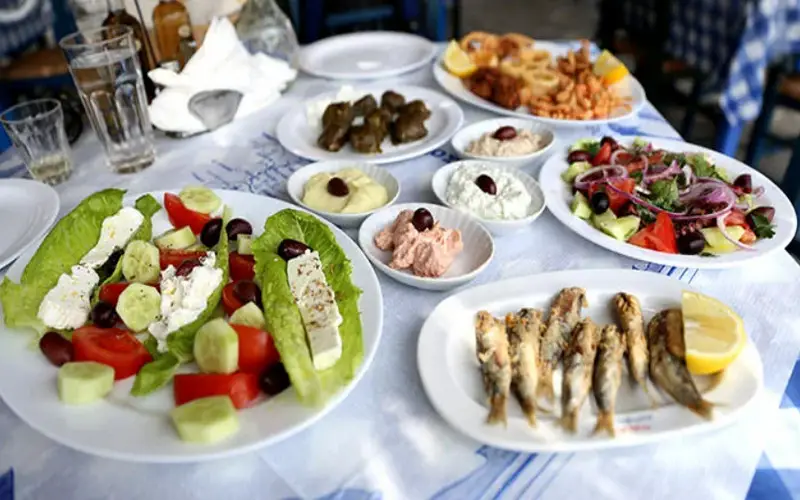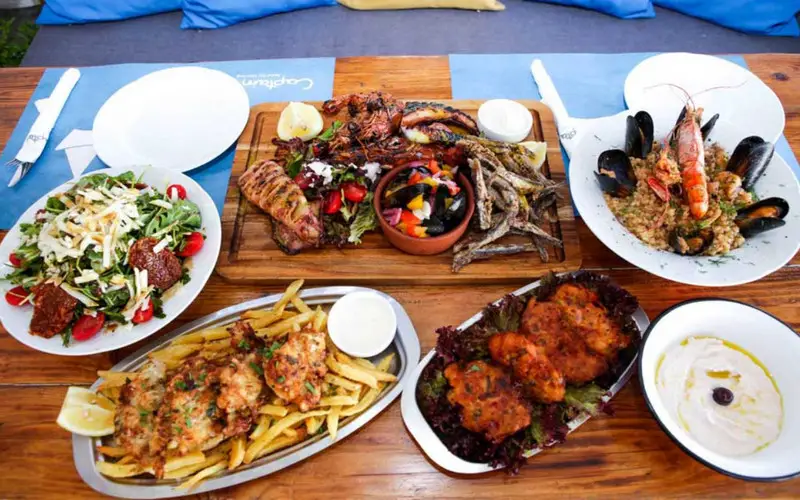Crete: The Gastronomic Gem of the Mediterranean

Crete, the largest Greek island, is a food lover’s paradise. The island’s cuisine is a blend of traditional Greek flavors with influences from the Middle East, North Africa, and Italy. Crete is famous for its olive oil, honey, and a wide variety of fresh vegetables and herbs. The Cretan diet is often associated with longevity and health, making it a must-visit destination for foodies.
Don’t miss the opportunity to taste traditional dishes like dakos (rusk topped with tomatoes, olive oil, and feta), Cretan cheeses like graviera and mizithra, and succulent lamb slow-cooked with aromatic herbs. Visit local tavernas and explore bustling food markets to savor the island’s authentic flavors.
Naxos: The Cycladic Culinary Delight

Naxos, the largest of the Cyclades, is a food lover’s hidden gem. The island’s fertile land ensures an abundance of fresh produce, while its position in the Aegean Sea provides an array of seafood options. You’ll find excellent cheeses, including the famous Naxian graviera, and the local potatoes are the best in Greece.
For a true culinary experience, try the Naxian kitron liqueur and visit the charming village of Halki, where you can explore traditional distilleries. Naxos offers a perfect mix of farm-to-table dining and fresh seafood, all with a view of the beautiful Aegean Sea.
Santorini: A Volcanic Feast for the Senses

Santorini, known for its stunning sunsets and dramatic landscapes, also offers a remarkable culinary experience. The island’s volcanic soil produces unique flavors, making its produce distinct and sought after. Tomatoes, white eggplants, capers, and an array of herbs flourish here.
Santorini is famous for its white aubergine moussaka, fava bean puree, and fresh fish dishes. Additionally, the island’s wineries produce some of the finest wines in Greece. Visit a traditional taverna, sip Assyrtiko wine, and savor the local specialties while taking in the breathtaking views.
Mykonos: A Gourmet Paradise in the Cyclades

Mykonos, renowned for its vibrant nightlife, also offers a culinary scene that will delight foodies. While Mykonos has numerous high-end restaurants, it’s also home to traditional Greek tavernas serving local delicacies. Try kopanisti, a spicy cheese spread, and louza, a cured pork, which are unique to the island.
The abundance of fresh seafood ensures that dishes like barbouni (red mullet) and astakomakaronada (lobster pasta) are a seafood lover’s dream. Mykonos is also known for its bakeries, where you can indulge in sweet treats like amygdalota (almond cookies) and melopita (honey pie).
Rhodes: An Island of Culinary Traditions

Rhodes, located in the southeastern Aegean, is a culinary crossroads, blending Greek, Ottoman, and Italian influences. The island is known for its rich, hearty dishes, such as mousaka with bechamel sauce, stuffed vine leaves, and soutzouk loukoum (a sweet confection).
A visit to the island’s charming Old Town allows you to explore local food markets and try authentic Greek street food like souvlaki and koulouri (sesame bread rings). Rhodes offers a diverse culinary experience that reflects its historical heritage.
Corfu: A Taste of Venetian Elegance

Corfu, an Ionian gem, boasts a cuisine influenced by Venetian and British colonial periods. The island’s cuisine features a wide range of dishes, including pastitsada (pasta with meat sauce), bourdeto (spicy fish stew), and sofrito (beef in garlic sauce). Olive oil, citrus fruits, and herbs play a prominent role in Corfiot dishes.
For a true Corfiot experience, visit the Liston in Corfu Town, an elegant esplanade filled with cafes and restaurants, where you can enjoy kumquat liqueur and local sweets like mandolato and pasteli.
Paros: A Food Lover’s Paradise in the Cyclades

Paros, a less crowded Cycladic island, offers a delightful culinary experience. The island is known for its delectable cheeses, particularly mizithra and xinotyri. Parian wines and the local spirit souma are also worth trying.
Visit the island’s fishing villages to sample the freshest catch of the day, and explore traditional tavernas where you can indulge in local delicacies like marathopita (fennel pie) and kakavia (fisherman’s soup). Paros combines authenticity and simplicity, making it a paradise for foodies.





















